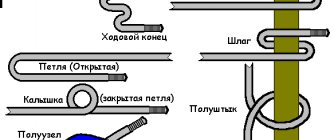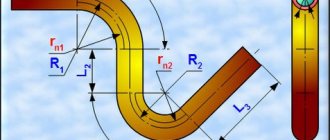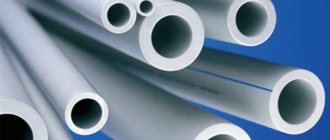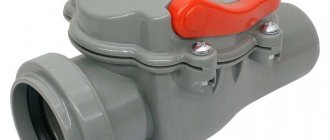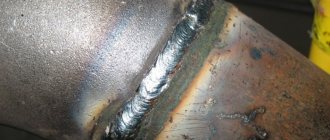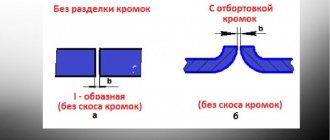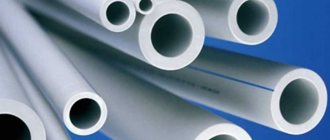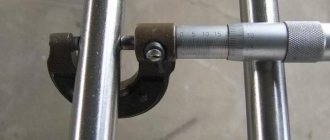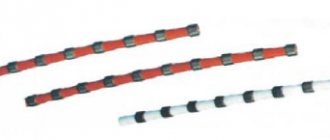Published 12/18/2015
If there is a blockage in the sewer pipes, you need a plumbing cable (also called a “flexible shaft”): with its help you can remove even the most difficult contaminants. You can buy it or make it yourself. In the first case, you will receive a professional tool that can be used repeatedly to work with any blockages. In the second case, you can quickly and inexpensively remove the “plug” in the pipeline system using improvised means, but working with a homemade cable is not as convenient as with a factory-made product.
Plumbing cable design
Cleaning cable with brush attachment
These plumbing products vary in length, diameter, and type of nozzle. They consist of the following elements:
- rod;
- handles used for rotation;
- nozzle that breaks up the blockage.
The most popular are products 5 meters long, the core of which is made of five strong wires and wrapped with wire in several layers, and the layers are applied in different directions - counterclockwise and clockwise. This device is sufficient for cleaning sewer pipes in an apartment or private house.
Most of the range is made from galvanized hardened steel ST70. This material is at the same time resistant to corrosion, mechanical stress, can withstand up to 3.5 thousand revolutions per minute, and is elastic. The thickness of the zinc layer, wire cross-section and other parameters must comply with GOST standards.
Dependence of cable diameter on wire cross-section
| Rope diameter (mm) | 1-1,2 | 1,4 | 1,6 |
| Wire cross-section (mm) | 1,4 | 1,9 | 2,1 |
The plumbing cable is resistant to twisting. It is used for cleaning:
- sewer and water pipes;
- pipelines fed from boilers and boilers;
- storm drain
The difference between household and professional products is significant. The latter are distinguished by their large diameter and length, the presence of comfortable handles, stands and devices that reduce the required force.
What is a flexible shaft
Section diameter and functionality
The product is made of spring steel and has a flexible contour, due to which it can bend in accordance with the turns of the pipe. This greatly facilitates cleaning the sewer with your own hands: by skillfully guiding the cable, you will be able to reach the most inaccessible places. Cables can have different cross-sectional diameters. If it needs to be enlarged, the core is wrapped with wire. The table below shows the recommended diameters of such flexible shafts depending on the pipe cross-section:
| Drain pipe diameter | Rope diameter |
| from 110 mm and above | more than 16 mm |
| from 50 mm to 110 mm | from 10 mm to 16 mm |
| up to 50 mm | less than 10 mm |
If desired, you can connect an electric or mechanical drive to the cable. This can be done by stamping or welding by attaching an adapter to one of the ends of the product. The other end of the cable - the working one - is passed into the pipe. You can choose attachments for it, depending on the expected complexity of the blockage.
Photo: cables for drain cleaning and attachments for different pipe diameters
Types of cables
Depending on the geometric parameters and material of manufacture, there are two types of flexible shafts:
- spring-twisted - an elastic metal spiral, the turns of which are tightly pressed to one another;
- rope - a flexible rope with a steel core, has a small diameter of up to 12 mm and is used for working with simple contaminants.
A spring-twisted cable for drain cleaning is used by professional plumbers. This product is quite expensive, so they don’t buy it for future use: since serious blockages rarely occur, a flexible shaft will not pay for itself. Rope products are characterized by lower efficiency, but are cheaper. These are the tools that are used to clean sewer pipes with your own hands.
Homemade cables are used occasionally. They are suitable for removing the least severe clogs. Using such a tool, for example, it will be very difficult to remove a solid object from a pipe.
What kind of blockages can be cleared with the product?
Hose design
Although a drain cleaning cable is considered a universal tool, not all types of clogs can be removed with it.
Operational blockage - consists of small organic deposits arising from fatty deposits, that is, food waste. The cable will clear such a blockage quickly and relatively easily.
Technological blockage - occurs in difficult sections of pipes, for example, on a bend at a large angle or when the diameter of the pipe does not match the purpose of the sewer, or when the diameter in old pipes is narrowed due to lime deposits. You can clear such an area with a cable, but the blockage will form again and again until the cause is eliminated.
Mechanical blockage - the lumen of the pipe is blocked by a large element - a rag, a bag, construction waste. In such cases, a sewer cable will not help much; it is necessary to disassemble the pipe and remove the blockage manually.
Using a plunger
The best result can be achieved if, after destroying the blockage using a plumbing cable, you additionally clean the drain system with a plunger.
The order of its use is as follows:
- If the sink or sink is equipped with an overflow hole, it must be plugged. Otherwise, it will be impossible to achieve the required pressure in the sewer pipe.
- The plunger should be placed over the drain hole, pressing the edges of the rubber part tightly against the surface of the sink.
- Next, you need to make several translational movements without lifting the device from the hole.
- Then you should sharply tear the plunger away from the drain. Most of the debris will spill out.
Using a plunger and cable to remove blockages
At the end of the procedure, the sewer system is washed with a large amount of boiling water. Pipe cleaning cable
Types of plumbing cables
Rope rope
Existing types of cables differ in technical characteristics and features of use.
Rope (rigging) - an affordable device with a diameter of up to 6 mm and a length of 2.5 to 5 m. It looks like a tightly twisted rope made of small wires, the ends of which are crimped so that it does not unfold. But if one of its ends is developed, the product will be even more effective at clearing pipes from simple blockages, the so-called operational ones. The design is elastic and flexible, so it fits well around the bends of the sewer network.
Flexible plumbing cable (also called a flexible shaft) - its basis is a metal rod on which a metal spiral is wound, sometimes in several layers. A handle is attached to one of the ends, which is rotated in one direction when removing the blockage. This breaks down the blockage and pushes it further down the pipe to a wider area. Length – up to 60 m, diameter – up to 28 mm.
The metal tape is a flexible structure designed to break through blockages in large diameter sewer pipes. It is distinguished by the presence of a quadrangular peak at the end. Length – up to 30 m, width – up to 25 mm. When folded, it takes up less space, but is not entirely convenient, since it bends only in one plane.
The spring type is similar to a flexible shaft and consists of a coiled spring. Length – up to 25 m, diameter – up to 13.5 mm. Spring products in a plastic braid are used for cleaning plastic pipes so as not to damage the pipes themselves from the inside, as well as the cavities of the plumbing fixtures.
The tensioner is a professional equipment. It should be used to clear complex blockages when other methods have failed. The products are characterized by increased rigidity, braided metal or vinyl. The handle plays the role of a tensioner, making the cable as rigid as possible. You can optimize the device using different attachments.
Electric is a professional plumbing tool. Such a cable is used where other equipment has failed or is inconvenient to use. They have a handle like a pistol, a drill, a cable wound on a drum, and a set of tips. No need to twist, rotation is automatic.
Spring and rope devices withstand less rotational load compared to other devices, since the rope cable is made of wire of small cross-section, and in a spring product the coils can move relative to the axis.
Types of nozzles
Variety of interchangeable attachments
The attachments vary depending on the purpose. Replaceable ones are installed on a threaded connection and replaced if necessary:
- brush - used to remove organic deposits;
- auger - is a screw attachment resembling a drill, removes soft growths inside the pipe;
- punch or peak - for old and complex blockages that completely cover the lumen of the pipe;
- bottom nozzle – designed to remove construction debris;
- hook - will help you get objects that have fallen into the sewer;
- harpoon - a nozzle that combines the properties of a punch and a hook, simultaneously pierces and picks up the blockage to remove it;
- scraper - designed to remove deposits from pipe walls; it consists of two curved plates with notches.
Less popular attachments:
- in the form of a sphere - for removing sand and lime;
- tetrahedral knife - for removing roots;
- blade - for gypsum and silt deposits.
Any nozzle is selected taking into account the diameter of the pipe: the larger the diameter of the sewer, the larger the diameter of the nozzle should be.
Types of handles
Most plumbing cables for cleaning domestic drains have a rotary handle as a handle. Professional devices are equipped with a plastic or wooden handle, reminiscent of similar elements on a pistol or drill. They are equipped with an electric drive or gearbox that reduces resistance and a stand. All improvements make the process of drain cleaning easier, since the work of removing complex blockages with a long, large-diameter tool is labor-intensive.
The cost of professional devices is much higher than the price of household appliances, so they are used by plumbers who clear blockages every day. In other cases, purchasing expensive equipment is not cost-effective.
Metal tape
Sewer cleaning tape ( length – 7-30 m, thickness – approximately 3 mm, width – 25 mm ) is another device that is gaining widespread use. Its elastic and fairly solid design allows you to clean pipes over a fairly long distance. To break through blockages, put on an attachment similar to a quadrangular peak. The tape is equipped with a comfortable handle.
Due to the fact that the above-mentioned devices used in the mechanical sewer cleaning method differ in design , you can successfully remove blockages without calling professionals.
How to choose the right accessory
Plumbing cable - an alternative to chemicals
The type and size of the sewer cleaning cable are selected taking into account the diameter of the pipes and the characteristics of the blockage. The diameter of the cable is directly dependent on the diameter of the pipes:
- to clean pipes up to 50 mm in diameter, use a cable with a diameter of no more than 10 mm;
- for pipes with a diameter of 50-110 mm, a cable of 11-15 mm in diameter is required;
- for pipes more than 110 cm in diameter - a cable with a diameter of more than 16 mm.
Moreover, to clean the sewerage system within an apartment, a tool with a diameter of 6-10 mm is sufficient, for a common one - 12-16 mm, for an industrial one - 16-20 mm.
To clean a small-diameter plastic pipe, use a thin flexible cable with a diameter within a centimeter.
The more turns the sewer system being cleaned has, the thinner the wire from which the cable is made should be.
For cleaning long systems with medium-sized pipes, the diameter of the cable may be slightly larger than recommended, but it is important that it is quite flexible.
Why use such devices?
A drain cleaner is a long, rope-like steel device with a handle for turning. It is pushed into the place where the plug has formed, and then they begin to scroll. With the help of rotational movements, the cable is able to wind fibers around itself during the cleaning process, as well as fibrous objects that could cause a blockage.
Quite often, rags, lumps of hair or wool, and paper get into the pipes. All these seemingly harmless items can cause serious problems. But they can be easily removed thanks to the cable. A very simple device can solve really serious problems.
If the accumulated debris in the pipes is not removed in time, the entire sewer system may simply fail. Flooding, burst pipes - all because of a few hairballs or furballs. Therefore, in order not to wait for services that can clear the drain, they came up with such an effective economic device.
How to make a cable with your own hands
The base is made of flexible twisted wire. Thick wire is not used, as it bends poorly. To make it easier to remove the blockage, the tip of the wire is flattened with a hammer or fluffed. The opposite end is bent into a ring to make it convenient to hold. A homemade device is used to clean sewers 3-5 m long.
Another option is a gas flexible hose. A nozzle is attached to one end with a reliable connection so that it does not unscrew during the process and does not remain inside the pipe.
The third option is a steel cable. All you need to do is select a piece of the required length and fluff the tip like a brush. And so that it does not unravel where it is not necessary, at some distance from the end it is fastened with a metal wire clamp.
The fourth option is a device made from a plastic bottle. It is cut in a spiral, creating a long ribbon. It is cut along the edges, making many small notches that will effectively clean the walls of the pipe.
How to clean a pipe
Using a plumbing cable
Most often, a blockage occurs in the siphon, so before using the cable, first unscrew the siphon and wash it. This will solve the problem in most cases.
Before starting work, inspect the cable for clearing a clogged drain for damage, since a piece of tool stuck in the pipe will only aggravate the problem. In addition, it is recommended to lubricate the rotating elements.
Next, proceed according to the following instructions:
- An oilcloth is laid on the floor. Put rubber gloves on your hands.
- After unscrewing the siphon and removing the sealing plug from the outlet pipe, the end of the cable with the nozzle on it is lowered into the drain of the sink, bathtub or toilet.
- The tool is pushed deeper and deeper by pushing it with one hand and turning the handle clockwise with the other. The tool is gradually unwound. When the cable encounters a blockage, it will be more difficult to turn it, but the speed will increase. In difficult cases, the cable is removed from the pipe, cleaned and lowered into the pipe again, continuing to break through the blockage with jerking movements.
- When the plug is removed, rotation will immediately become easier.
- After removing the blockage, rotate the handle for some time to get rid of the blockage completely. This will not allow it to settle in a new place and will completely destroy it.
- At the end, flushing the drain with hot water is necessary to completely remove any remaining blockage.
After making sure that the problem has been resolved, the siphon is installed in place, and the cable is put away for storage.
Tips and tricks
Useful tips will help you clean the drain efficiently and keep your tool in good condition for a long time:
- After use, the cable must be washed, dried well, lubricated with technical oil and put into a paper bag or wrapped in paper, rolling the tool into a coil. It is not recommended to store it in a sealed plastic bag.
- When cleaning the sewer, hold the shaft with the other hand, controlling the progress of the work.
- When flushing the drain after removing the blockage, you can add a degreaser to the water.
If the water forms a funnel when draining, it means that the sewer has been cleaned efficiently.
Care
The multifunctional characteristics of a sewer cable depend not so much on the materials used in its manufacture, but on proper care.
After use it is recommended:
- Thoroughly clean the surface from sewer contaminants. This is done carefully under hot running water, using a rag;
- Upon completion of cleaning, all components are thoroughly dried. This is necessary to prevent the formation of a corrosive layer;
- The final step is to apply a thin protective layer of oil and wrap it in thick paper.
